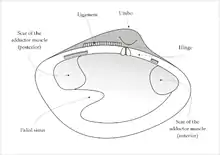Umbo (bivalve)
The umbo (plural umbones or umbos) is the vaguely defined, often most prominent, highest part of each valve of the shell of a bivalve or univalve mollusk. It usually contains the valve's beak, the oldest point of the valve, and its degree of prominence and its position relative to the hinge line are sometimes helpful in distinguishing bivalve taxa.[1] The umbo forms while the animal is a juvenile, and radial growth subsequently proceeds around that area. The umbo is situated above the hinge line. In those bivalves where the umbones do not protrude, as is the case for example in some mussels, the umbones can nonetheless usually be readily identified by examining the concentric growth lines of the shell.[2][3]




2:Growth lines
3:Ligament
4:Umbo
Umbo is also in use in anatomic descriptions of brachiopods, for the origin of growth of the valves.
See also
References
- Brink, Laura A. "Mollusca: Bivalva" (PDF). University of Oregon. Retrieved 27 May 2017.
- "Advanced glossary of molluscan terms | The Conchological Society of Great Britain and Ireland". www.conchsoc.org. The Conchological Society of Great Britain and Ireland. Retrieved 27 May 2017.
- "Bivalves". www.manandmollusc.net. Archived from the original on 5 May 2012. Retrieved 27 May 2017.